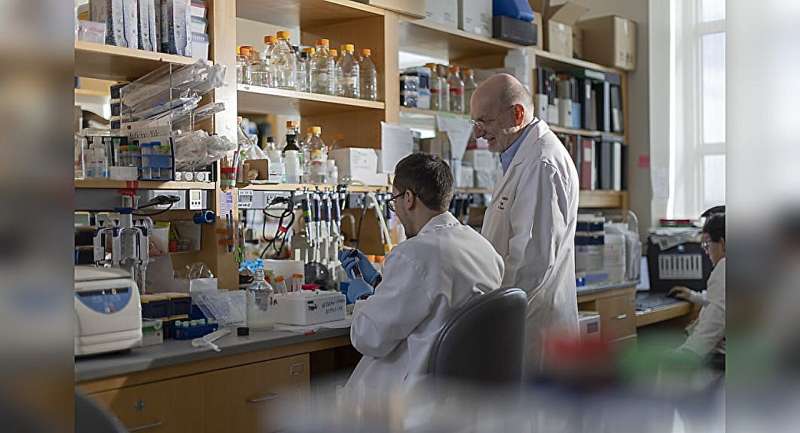This article has been reviewed according to Science X's editorial process and policies. Editors have highlighted the following attributes while ensuring the content's credibility:
fact-checked
peer-reviewed publication
trusted source
proofread
Study identifies new gene target for polycystic kidney disease

An unsuspected gene, Glis2, has been found to be a target of polycystic kidney disease (PKD) signaling in preclinical models.
PKD is an inherited disorder that leads to fluid-filled cysts developing on the kidney. These cysts enlarge the kidneys, reduce kidney function, and ultimately lead to kidney failure.
While the genetic basis for inheriting the disease is well established, how this causes cyst formation is not fully understood. For decades, scientists have been seeking a better understanding of PKD and what causes cyst growth.
New research from Yale School of Medicine has discovered that the gene Glis2 is a component of PKD signaling and may also be a new target for the treatment of the disease. The paper, "Glis2 is an early effector of polycystin signaling and a target for therapy in polycystic kidney disease," is published in Nature Communications.
The moment the team discovered the gene target has been described as "unforgettable" by Michael Rehman, Ph.D., associate research scientist (nephrology) and co-first author of the paper.
Another co-first author Chao Zhang, Ph.D., remembers the excitement, "When I got the first in vivo data, which showed the perfect rescue of polycystic kidneys by Glis2 knock-out, I was so excited and could not wait to share the data. At the same time, I tried really hard to calm myself down and thought about the next steps to confirm this result."
Until now, the Glis2 gene was not included in any of the known pathways that have been investigated for PKD.
"Glis2 has not been suspected to be a component of the signaling pathways involved, but our research shows it's quite centrally positioned in polycystin signaling," said Stefan Somlo, MD, C. N. H. Long Professor of Medicine (Nephrology) and professor of genetics; chief, Section of Nephrology, and corresponding author on the study.
About a decade ago, Somlo's lab was investigating the role of cilia—minute membrane projections that cells use to sense outside signals—in PKD.
They described a phenomenon in which PKD is present when polycystin genes are inactivated in cells with intact cilia, but surprisingly, they found that when the cilia were also inactivated, PKD was suppressed despite the absence of polycystins. This suggested there was some process that is dependent on the presence of intact cilia—and absence from those cilia of polycystins—that drives cyst growth.
Building on this, Zhang, as part of his thesis project, used RNA sequencing to identify gene expression changes specifically present in polycystin knockouts with intact cilia.
"Among these genes, most of them are not well studied and completely new to ADPKD [autosomal dominant polycystic kidney disease], which makes our work very hard. On the other hand, it brought us the opportunities of finding new factors or pathways," explains Zhang. It led to the discovery of the role of Glis2 in PKD.
"For a long time, we tried to see the Glis2 protein in western blot. And one weekend, on a Sunday, I was going to throw away some cells with the Pkd1 knockout. Then I thought, instead of throwing them away, let's try to do fractionation of nuclear and cytosolic portions and test by western blot for Glis2. That evening the result that I got was one of my best observations–it validated our observations on mRNA expression at the protein level," said Rehman.
Somlo emphasizes how the approach they used was unbiased. "In the field, there are a relatively large number of targets proposed for polycystic kidney disease, but they don't coalesce into a few common pathways. And sometimes when that happens, you have to worry that you may not have found the most compelling mechanism."
"We didn't assume any specific pathway. We wondered if all we assumed was the differences in phenotype, what gene expression changes would be found between polycystin-only knockouts that form cysts when compared to both noncystic controls or noncystic polycystin and cilia double knockouts."
The research team focused on changes in 73 genes and, ultimately, selected Glis2 as the best candidate for further validation.
"Around five years ago, when I started to work in the ADPKD field, I asked many people about what markers are good to see in western blots for cells with Pkd1 KO, and no one had an answer. But, now we have Glis2 as a very robust marker after a lot of systematic analysis in multiple in vitro and in vivo models," says Rehman.
As part of the study, the investigators also treated models with antisense oligonucleotide (ASO) directed against Glis2, which they found suppressed the growth of cysts.
The selective inactivation of Glis2 was carried out by Xin Tian, MD, associate research scientist (nephrology) and co-first author of the study. Tian evaluated preclinical models whose disease progression was similar to human disease.
"When I found that the disease progression was significantly prevented in in vivo studies, I was very excited and realized that the Glis2 can play a crucial role in further dissecting PKD signaling and enriching our understanding of mechanisms of the human ADPKD, and also could lead to developing treatments of the disease."
Overall, the study went from discovery to genetic validation in cell culture systems and in preclinical models, and then used a therapeutic agent for further proof of concept, so this can be considered a fairly complete preclinical study, mentions Somlo.
The next step in their research is to dig deeper into how Glis2 operates, including how polycystin results in the upregulation of Glis2 and what upregulation of Glis2 does functionally, and, most importantly, whether it's applicable to humans.
More information: Chao Zhang et al, Glis2 is an early effector of polycystin signaling and a target for therapy in polycystic kidney disease, Nature Communications (2024). DOI: 10.1038/s41467-024-48025-6




















